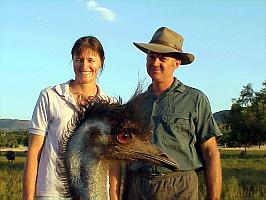by James Cameron
A Story With Pictures
I live in the eastern outback area of Australia, where temperature is a fairly common topic. It's usually either too hot or too cold. It never rains enough, except when we get floods. A land of deserts and flooding rains, as Dorothy said. This story and pictures are true.
The Emus
The emu farm up the road, needed a way to know when their emu fat freezers had failed. They have three freezers, and fill them gradually. Fat is removed from the emus during summer and stored frozen before being processed into emu oil. The meat is used for food, the feathers for dusters and concrete reinforcement, and the skins for leather.

An Emu
The Dodge
One particular freezer that was giving trouble is on the back of a Dodge truck. However, there were certain things that could be done to get it going again, if you knew it was not working. But the shed which has the freezers is a long way from the house, and being in the Australian outback, freezer mechanics are rare. Advance warning of a problem would be useful.
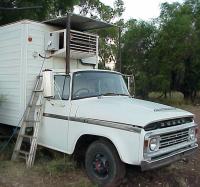
Freezer Truck
The Shed
Typical galvanised steel construction with concrete floor. Cheap and effective. Terribly hot in summer, freezing cold in winter. Surrounded by trees, so I couldn't get a good photograph of it. Here's another one a hundred metres away, with the mountains in the background.
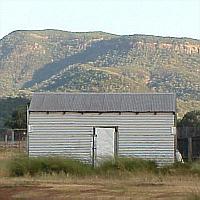
Shed
The Sensors
The assembled temperature sensor kit was placed in the shed near the freezers, with four sensors attached. One went to each freezer, and one measured ambient shed temperature. Right now (3rd March 2001) it is still in operation.Nice blue Cat 5 networking cable connected two of the sensors; then I ran out and had to use some old DECconnect cable. I used heat shrink on the cable ends and connectors to add a bit of strength, and to keep out water, insects and spiders.
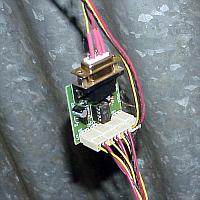
Microcontroller Kit
The Details
I placed 0.1uF capacitors on the ends of the cable where the sensors were, because I had observed a bit of movement in the data without them. I also encapsulated each sensor in a bit of heat shrink.Now, the shed was a fair whack from the farm house. About two hundred metres. So directly cabling the RS-232 signal over that distance was a bit dubious; especially since lightning strikes are common over summer in the area. Two old 2400 baud modems were used instead. Dataplex DPX224 modems, from the car park junk pile at Digital Equipment Corporation in Rhodes, Sydney. Nice professional metal cased units, with built-in transformer; not today's plastic ones with a plug-pack. Another plus was that the microcontroller already ran at 2400 baud. The front panel switches came in handy as well.
Ah, but the modems weren't generating a high enough voltage for the 78L05 voltage regulator on the kit. I had to replace that with an LM2936 low-drop variant. Better that than find another power source.
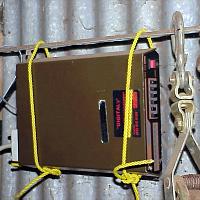
Old 2400 Baud Modem In Shed
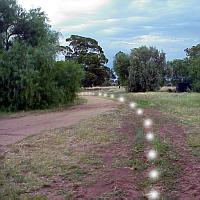
Path of Cable
|
|
|
|
|||||||||
| \ | | | | | | | | / | Cat 5 Cable | ||||||||
| ||||||||||||
| | | RS-232 Cable | |||||||||||
| ||||||||||||
| | | | Buried Telephone Cable | |||||||||||
| ||||||||||||
| | | RS-232 Cable | |||||||||||
| ||||||||||||
Equipment Connections
The Cable
Then there was the telephone cable to lay. Initially, we just laid four core internal telephone cable over the ground while we tried to find some better cable. Eventually, we used black polyethylene coated grease filled telecommunications lead-in cable, buried using a ripper blade on the back of a tractor with a one-inch diameter steel pipe spot-welded to it on the day. We used polyethylene half-inch irrigation pipe inside the steel pipe and threaded the cable through that, just to make sure it didn't catch.It was a big day, and way outside my comfort zone. Next time I have to do such a thing, I want to try radio! No cables required.
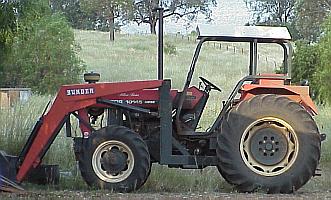
Tractor
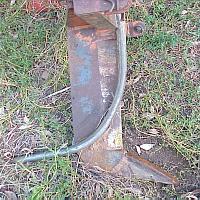
Ripper Blade with Steel Pipe
The Laptop
The cable went to the house, to the other modem, and a serial cable connected the modem to the back of a second hand 486/33 laptop running Debian GNU/Linux. The modems were set to leased line operation, with one set to originate and the other set to answer. A variant of the temperature sensor logger program was created, with variable limits and ability to graph the day's temperatures using gnuplot.
- emu.c the modified tsl.c with a screen layout to match the sensors in use, with limit sensing and alarms using the parallel port, and with an ability to run the ...
- emu.sh graphing script, which calls gnuplot to plot the data in colour on the VGA LCD panel.
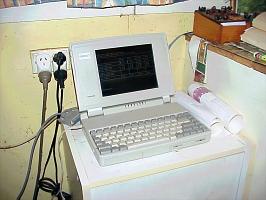
486/33 Laptop
